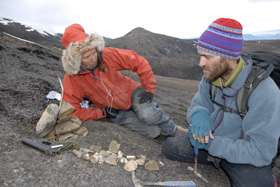Sea monster search draws MSU scientist to land of polar bears

The search for ancient sea monsters sometimes calls for extreme paleontologists. Pat Druckenmiller, for one, flew 800 miles away from the North Pole, rode a boat across an icy fjord and jumped into the sea to reach the shore where no one lives except polar bears and reindeer.
Then the Montana State University scientist hiked, rifle in hand, across an Arctic island to map the remains of 28 sea reptiles that are 150 million years old. The biggest, a predator nicknamed "The Monster," had a skull as long as seven feet and a body as long as 40.
After pitching his tent in the tundra, Druckenmiller helped set up a trip wire system to scare polar bears away from camp. Then he ate fat -- lots of fat -- to keep warm.
"We ate and ate and ate. I ate the fattiest sausage I could find. I ate nothing but fat," said Druckenmiller, who traveled to the Arctic last summer with a team of Norwegian-led scientists. A slim expert in prehistoric marine reptiles, Druckenmiller said he likes winter camping, but this was August, for goodness sake.
When he accompanies the team next summer, he expects to use boiling water to free the fossils from their black shale graveyards and chemical additives to keep plaster from freezing, Druckenmiller said. Paleontologists mix plaster when they're ready to remove fossils. They dip burlap into the plaster and lay it over the bones so it forms a jacket. When the plaster is dry, the fossils are stable and ready to move.
He also hopes to see polar bears next summer, but from a safe distance.
"To collect marine reptiles, we have to live in the presence of a marine mammal -- polar bears," said Druckenmiller who didn't encounter any last summer, but was prepared.
Polar bears roam around in the town of Longyearbyen on the island of Spitsbergen. Many of the town's residents knew about fossils in the area, but students from a small local university found the fossils that prompted the University of Oslo Natural Geological Museum to investigate in 2004, Druckenmiller said. After uncovering the complete skull of an ichthyosaur and parts of two plesiosaur skulls, the paleontologists planned a return expedition in 2006. They are currently planning to go back in August 2007.
"The site we have chosen for next year's excavation is on a hillside with several exposures of shale," Jorn Hurum, co-leader of the team, wrote in an e-mail from the University of Oslo in Norway. "There will be three digs going on at the same time within five to 10 minutes walking distance."
The paleontologists will start by excavating "The Monster," an ichthyosaur and a smaller long-necked plesiosaur, but the site will be worked for several years, Hurum said.
Ichthyosaurs resembled dolphins, but had an upright tail fin. Plesiosaurs come in two types. One -- like the marine reptile found in Montana in August and the majority of Arctic specimens -- had a long neck and relatively small skull. The other -- like "The Monster" -- had a short neck and massive skull.
"This is a matter of national pride," Druckenmiller said about the discovery of such fossils on property over which Norway has sovereignty. The island of Spitsbergen is part of the Svalbard archipelago administered by Norway.
Druckenmiller, the only marine reptile specialist on the team, heard about the expedition in May 2006, flew out in July and spent 12 days during August in the Arctic.
"I just love the opportunity to do stuff like this," he said.
Hurum, an associate professor in vertebrate paleontology, said, "He contributed a lot to the identification of all the specimens we found."
Druckenmiller said only a handful of paleontologists in the world focus on marine reptiles, so he feels like a pioneer. The marine reptiles he studies existed before whales and at the same time as dinosaurs. "The Monster," he said, was like an underwater T. rex, but wasn't a dinosaur.
Source: by Evelyn Boswell, Montana State University




















